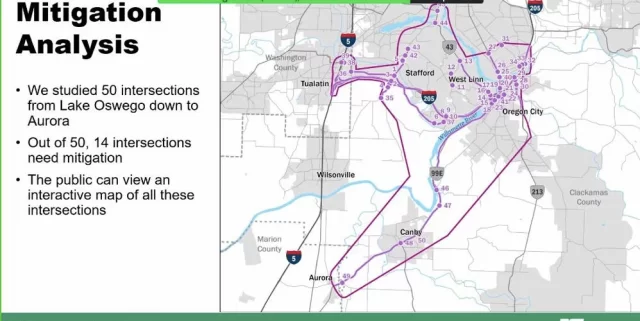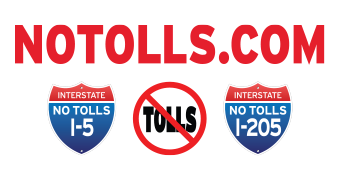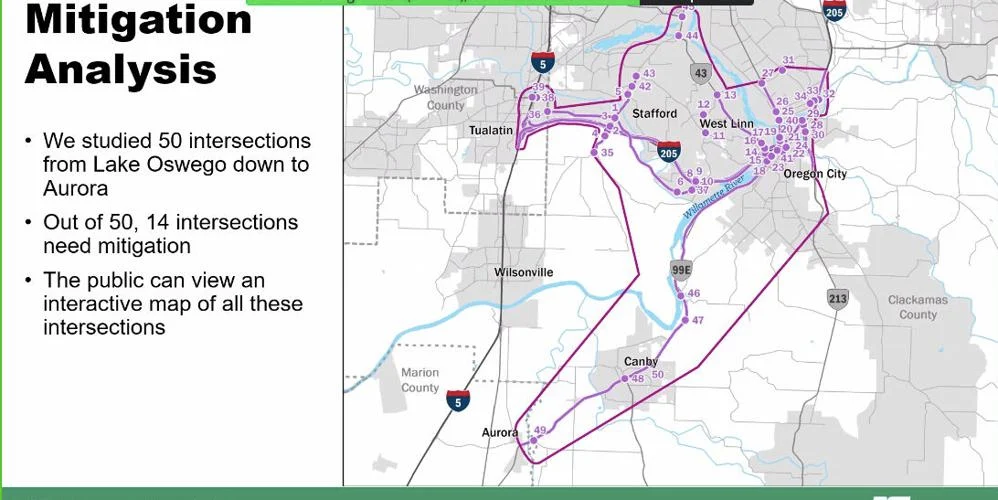Tuesday, the public comment period is now open for the I-205 toll project.
- Feb 21, 2023 (Portland Tribune)

(ODOT graphic)
Tolling in Oregon is moving forward — and coming soon to bridges along I-205.
Tuesday, Feb. 21, the I-205 Toll Project Environment Assessment report from the Oregon Department of Transportation and the Federal Highway Administration was released. ODOT is now accepting public comment on the topic, as well.
With the tolls as a new source of funding, ODOT has plans for a number of transportation improvements for Oregonians who travel and commute.
ODOT’s Mandy Putney, urban mobility office strategy initiatives director, and Brendan Finn, director of the urban mobility office, commented on the topic Tuesday.
“Right now we are in listening mode as it relates to this project,” Finn said. “There has only been some limited implementation of (tolling) in the state’s history, but we are moving forward on the first project, which is the I-205 toll project, and this will be two totally different projects on two bridges.”
The first two bridges slated for upgrades as part of the project include the Abernethy bridge and the Tualatin bridge, both along I-205. Both projects are slated to begin having toll systems operating in the fourth quarter of 2024, according to Finn.
He said Oregon critically needs to modernize its transportation system to make sure we’re prepared for the possibility of the Cascadia Subduction Zone earthquake.
“When we have that seismic Cascadia seismic event. It’s a lifeline route that is relied upon, not only for moving goods and services and people but emergency responders. And these improvements that we’re going to be making around the entire corridor,” Finn said.
Now that the environmental assessment study is ready, it’s a critical milestone for the tolling projects, according to ODOT.
“First and foremost, making this ready for Cascadia-level earthquake event, nine bridges need to be updated or replaced,” Putney said.
Parts of the project include adding sound walls, making improvements for cyclists and pedestrians, and making the highways safer. With the toll funds, I-205 will be widened from two to three lanes in both directions for seven miles. These improvements are expected to improve traffic travel times by 50% in the evenings and 25% in the mornings, according to ODOT, as well as 26% fewer crashes in the future.
“The environmental assessment is out as you heard today, and it talks about a variety of topics and provides detailed analysis,” she said. “We’re asking the public to comment on the work that we’ve done so far, to let us know if we missed anything and how we did in terms of thinking through all of these issues.”
For example, ODOT heard travel patterns were an issue in certain places, like the I-205/Hwy. 43 interchange between West Linn and Oregon City.
“People can’t make the trip that they want to make. We’ve created a very large study area in response to the concerns that we’ve heard, identifying 50 specific intersections to analyze and research in our document,” she said. “We’re going to create a total project that really benefits I-205 travel without impacting local communities, and we do that by addressing the few areas where we do see impacts.”
A variety of options under consideration are laid out on the ODOT website with an interactive map, webinars and more tools for stakeholders to view.
The public comment period on this project is now open through April 7 online. (ODOT extended now to April 21st).
Next, ODOT plans to work closely with the Federal Highway Administration to determine next steps for the environmental decision, anticipated in mid-2023.
“(Tolling) is used around the country and around the world, to provide revenue for projects but also to create a more reliable system we desperately need here in Oregon right now,” he said. “We were the first state in the nation to implement gas taxes to pay for these needed investments to our transportation system, for our economy and also for the mobility of our residents of the state … We are right now on a financial cliff as it relates to revenue to fund our system to keep it in the state that it is right now.”
He said partly due to an increase in EVs and more fuel efficient vehicles, we’re seeing the electrification of the transportation system that is helping us reach our climate goals — but is also resulting in hundreds of millions in losses of gas tax revenue annually.
“That’s one of the major reasons why we’re implementing tolling,” he said. “Tolling is part of what we’re calling the bigger urban mobility strategy. This is a set of investments I’m going to show you on a map without going into too much detail, but really thinking about this system in the Portland metropolitan region in a comprehensive manner. So we can reduce traffic congestion, relieve some of those key bottlenecks, but also invest in other modes of transit, and biking and pedestrian improvements around the region so people have other ways to get around.”
Jules Rogers is editor of the Business Tribune.


